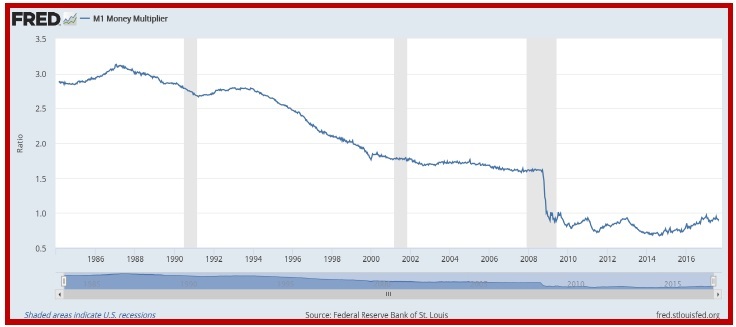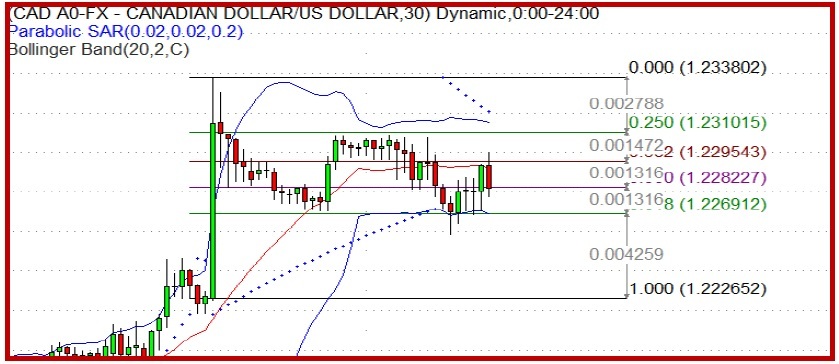Outlook:
The Fed starts its two-day meeting today and we will have the outcome tomorrow. Most observers expect the Fed will sound chirpy on Wednesday as well as affirming normali-zation with a reduction in asset purchases. The WSJ names it the Great Unwinding and says if all goes well, thus will end the greatest experiment in monetary policy of all time.
While zero (or negative rates) sounds absolutely crazy, QE did have the desired effect—low fixed in-come returns sent investors to riskier assets, mostly equities and real estate. The WSJ notes "Ultralow interest rates allowed millions of Americans to refinance, reducing foreclosures and freeing up cash for spending." For a borrower, it was the same thing as a tax cut. There was more hoarding than anyone ex-pected—banks preferred to stash their money at tiny rates of return rather than lend, and so while money supply did rise dramatically, velocity tanked and the money multiplier along with it. See the chart. We got that one right—Friedman may be correct that inflation is always a monetary phenomenon, but the money has to circulate and multiply to generate inflation. The money multiplier is starting to rise, gen-tly.
Normalization is indeed something to celebrate and we expect Yellen and the other Feds to beam with self-satisfaction and maybe a little victory hop or two. We should not begrudge them. Rejoicing at the good fortune of having succeeded in a weird and nearly unbelievable grand experiment is only to be expected. It's not actually all over, of course. The amount of un-replaced assets will be on the order of $1 to $2 trillion, a drop in the bucket of the $32 trillion Treasury market and $9.5 trillion mortgage-backed market. The Fed has been leading the fixed income horse to this trough for a long time and it is expected to drink without making a fuss or kicking up its heels. Still, the mortgage gang may gag a lit-tle.
Other things not strictly in the usual line of thinking by the FX market include yet another hurricane that already hit Dominica and is about to wreck Puerto Rico and maybe Florida, and another one be-hind that which could hit as far north as Connecticut. We are 40 miles inland but buying gas for the generator anyway. Keep in mind that after the first drop in consumer spending and rise in unemploy-ment after a natural disaster, activity picks up and can become inflationary.
We also have Trump speaking at the UN. The last time anyone speaking at the UN was a big deal was Colin Powell asserting Saddam had weapons of mass destruction—in 2003. Westerners have a hard time understanding what Trump really means and what he will continue to mean tomorrow and next week and next year, so it's no wonder the North Koreans don't understand him. They believe the US fully intends to invade and has always intended to invade. There is nothing Trump can say to relieve them of this idea and a lot he can say that could poke them into pre-emptive action. Eeek. Trump may also pull out of the Iran deal, which only reinforces the N. Korean idee fixe. The snot-nose equity guys are yapping about defense contractors (Northrop Grumman, United Technologies) as reaching for a bigger slice of the US defense pie. They are probably not wrong.
We got some Reader responses to our complaint yesterday about our fabulous technology not being fabulous enough to shoot a missile out of the sky. (It's always of interest that so many engineers turn to market analysis and FX in particular.... Two big-time technical analysts come from high-end engineer-ing, including Tushar Chande and Keith Fitschen). It turns out the problem is not being able to target the missile, but rather the short window of opportunity to get a counter-attack launch in gear—less than an hour. And if there are multiple missiles, the probability of missing one goes higher. Third, the Rosh Hashana holiday is Thursday and Friday, while Yom Kippur is on Saturday. Important holidays thin out trading desks and reduce activity across all asset classes, leading to the potential for jumpiness.
Finally, we complain all the time about not having access to information about position-adjustment fac-tors. This leads all the FX analysts to attribute price moves to whatever economic or political factor is on top at the moment, even though those factors might be irrelevant. This time we hear that $658 mil-lion in euro options expire today (at 1.1950) and another $500 million expire tomorrow at 1.2000. So far in the past 24 hours, the low is not quite to 1.1950 and the high is a little over 1.2000. Maybe we will get a breakout once the jockeying pertaining to these option strike levels is over.
Today the economic release is US trade prices and the current account deficit. These are not a market mover. Let's observe (again) that we lack a good filter for what is noise and what is actual news. A case in point is BoE chief Carney seeming to retreat from the hawkish stance of rising inflation necessi-tating a rate hike before year-end. The market reacted by selling sterling against the dollar but the sell-off was short-lived, as was a second effort to drive it down during the Asian session—but it's back above 1.3500 this morning. The euro had been dipping against the pound but not abnormally so (still inside channel). So, does the conventional wisdom of euro/pound parity still hold? Yeah, probably. Carney made a splash with his "news" but it's not actually news—it's noise.
Similarly, yesterday the CAD shed over 100 points in 30 minutes on a comment by Deputy Bank of Canada Gov Lane, who said the bank will be paying close attention to how the economy responds to higher rates and stronger currency. Definitely not news—what else would you expect a central banker to say—and yet the FX market twitched. This time it was moving the pre-existing trend direction, but the hard twitch afterward was a 62% retracement. See the mini-chart. This is noise, not news. It moves the market and sometimes by a lot, but lacks staying power.
We go through periods in the FX market that are trend-driven and traders focused on the hard news or at least hard suppositions, like the Trump Bump last November/December. Then we have periods when traders know the Big Picture trends but prefer to respond to noisy material, with wide swings dispro-portionate to the content of the new story, whatever it is. Nobody has ever figured out what non-news events will trigger a big move, or why some authentic Events fail to trigger a move when they "should." It's one of the things that makes FX different from commodities or equities and is probably a function of excessive complexity—too many factors and the inability to choose, quickly, which one to respond to... sort of like shooting down missiles. We are flighty today, shooting at pegeons instead of missiles. Watch out.
| Currency | Spot | Current Position | Signal Date | Signal Strength | Signal Rate | Gain/Loss |
| USD/JPY | 111.66 | LONG USD | 09/13/17 | WEAK | 110.05 | 1.46% |
| GBP/USD | 1.3506 | LONG GBP | 09/07/17 | STRONG | 1.3075 | 3.30% |
| EUR/USD | 1.1987 | LONG EURO | 06/28/17 | WEAK | 1.1218 | 6.86% |
| EUR/JPY | 133.84 | LONG EURO | 09/13/17 | STRONG | 131.76 | 1.58% |
| EUR/GBP | 0.8875 | SHORT EURO | 09/13/17 | WEAK | 0.9033 | 1.75% |
| USD/CHF | 0.9631 | SHORT USD | 08/10/17 | STRONG | 0.9655 | 0.25% |
| USD/CAD | 1.2283 | SHORT USD | 08/24/17 | STRONG | 1.2533 | 1.99% |
| NZD/USD | 0.7294 | LONG NZD | 09/13/17 | WEAK | 0.7282 | 0.16% |
| AUD/USD | 0.7996 | LONG AUD | 08/17/17 | WEAK | 0.7931 | 0.82% |
| AUD/JPY | 89.29 | LONG AUD | 09/05/17 | WEAK | 87.30 | 2.28% |
| USD/MXN | 17.7594 | SHORT USD | 09/15/17 | WEAK | 17.6890 | -0.40% |
| USD/BRL | 3.1363 | SHORT USD | 09/05/17 | WEAK | 3.1409 | 0.15% |
This morning FX briefing is an information service, not a trading system. All trade recommendations are included in the afternoon report.
Recommended Content
Editors’ Picks
EUR/USD holds above 1.0700 ahead of key US data

EUR/USD trades in a tight range above 1.0700 in the early European session on Friday. The US Dollar struggles to gather strength ahead of key PCE Price Index data, the Fed's preferred gauge of inflation, and helps the pair hold its ground.
USD/JPY stays above 156.00 after BoJ Governor Ueda's comments

USD/JPY holds above 156.00 after surging above this level with the initial reaction to the Bank of Japan's decision to leave the policy settings unchanged. BoJ Governor said weak Yen was not impacting prices but added that they will watch FX developments closely.
Gold price oscillates in a range as the focus remains glued to the US PCE Price Index

Gold price struggles to attract any meaningful buyers amid the emergence of fresh USD buying. Bets that the Fed will keep rates higher for longer amid sticky inflation help revive the USD demand.
Sei Price Prediction: SEI is in the zone of interest after a 10% leap

Sei price has been in recovery mode for almost ten days now, following a fall of almost 65% beginning in mid-March. While the SEI bulls continue to show strength, the uptrend could prove premature as massive bearish sentiment hovers above the altcoin’s price.
US core PCE inflation set to signal firm price pressures as markets delay Federal Reserve rate cut bets

The core PCE Price Index, which excludes volatile food and energy prices, is seen as the more influential measure of inflation in terms of Fed positioning. The index is forecast to rise 0.3% on a monthly basis in March, matching February’s increase.

